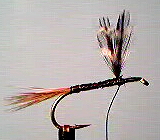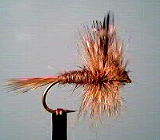Volume 3, Issue 7 July 2002
Traditional Adams Dry Fly
By Bob Ireton
Photography Bob Ireton, Tom Jones, Jorge Villares
This pattern is an 'all-purpose' attractor fly that can be tied and modified to imitate just about any adult insect. It will catch most any trout, bass, or panfish.
If someone asked you to name a traditional dry fly, I would say most people would come up with the 'Adams'. This pattern was originally tied about 1920 by Leonard Halladay, of Mayfield, Michigan, and named for his friend Charles F. Adams, of Lorain, Ohio. It has become possibly the most well known dry fly in this country. I think you would be hard pressed to find a fly fisherman who did not have this pattern in his fly box.
You can fish this fly best on slower water. Some current is certainly fine, but definitely not in fast, turbulent water. Whether you fish it upstream, downstream, or anyplace in between, the important thing is to fish it drag free. Make sure you keep several sizes of Adams in your fly box!
MATERIALS
| Hook - | -TMC 100, Dai-Riki 300, Daiichi 1100, Mustad 94840, Orvis 1509 size 10-22 |
| Thread | - Black 6/0 for size 12 and larger 8/0 for size 14 and smaller |
| Tail | - Grizzly and Brown spade hackle fibers-mixed |
| Wings | - Grizzly hen hackle tips |
| Body | - Gray Muskrat dubbing |
| Hackle | - Grizzly and Brown rooster neck hackle |
TYING STEPS
| 1 - Secure hook properly in vise. Pinch down barb, if desired. Tie in thread one hook-eye space behind eye of hook. Lay on a thread base back to a point above barb. | |
| 2 - From the spade feathers of a Grizzly and a Brown rooster neck, strip an equal number of fibers from each feather, and stack fibers so tips are aligned. Tie in the bunch of fibers at the point above barb, with the tips extending rearward the length of one full hook length. Half-hitch. Bring the thread forward to the wing tie-in location, using wide wraps. |
|
| 3 - Use two Grizzly hen neck
hackle feather tips for the wings. Tie in at a point slightly less than
1/4 shank length behind eye of hook, with the tips facing forward. The
wings should be the same length as the hook shank. Tie
upright-and-divided. Trim off excess butts. Bring thread back to point
above barb using wide wraps. Half-hitch. |
|
| 4 - Dub a tapered body forward,
leaving a space between body and wings for tying in and wrapping hackle. |
|
| 5 - Select one Grizzly and one
Brown hackle feather of the proper size, and prepare it to tie in just in
front of the dubbed body. Tie in with the shiny side facing toward eye of
hook, and the tips facing back. Bring thread forward to a point one
hook-eye length behind eye of hook. Half-hitch. |
|
| 6 - Wrap one hackle forward at a
time. Make three wraps behind wing, and three wraps in front. Secure
hackle tip with thread. Repeat with second hackle feather, and secure. |
|
| 7 - Trim excess hackle feathers.
Form a head, half-hitch, and whip finish. Add a small amount of head
cement. |
|
Copyright © 1998 - thisyear The Buckeye United Fly Fishers, Inc. Cincinnati, OH 45249
The Buckeye United Fly Fishers, Inc is a non-profit corporation organized under section 501(c)(3) of the Internal Revenue Code, incorporated in the State of Ohio for the preservation, conservation and wise use of our fishing waters and game fish; and to assist in the protection and improvement of our natural resources



